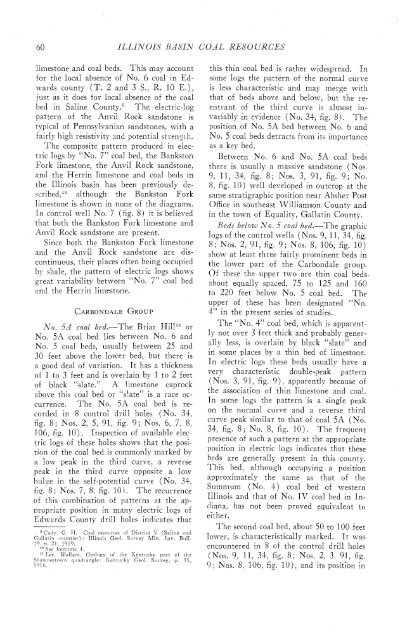subsurface geology and coal resources of the pennsylvanian system ...
subsurface geology and coal resources of the pennsylvanian system ...
subsurface geology and coal resources of the pennsylvanian system ...
Create successful ePaper yourself
Turn your PDF publications into a flip-book with our unique Google optimized e-Paper software.
60 ILLINOIS BASIN COAL RESOURCES<br />
limestone <strong>and</strong> <strong>coal</strong> beds. This may account<br />
for <strong>the</strong> local absence <strong>of</strong> No, 6 <strong>coal</strong> in Edwards<br />
county (T. 2 <strong>and</strong> 3 S., R. 10 E.),<br />
just as it does for local absence <strong>of</strong> <strong>the</strong> <strong>coal</strong><br />
bed in Saline County.Vhe electric-log<br />
pattern <strong>of</strong> <strong>the</strong> Anvil Rock s<strong>and</strong>stone is<br />
typical <strong>of</strong> Pennsylvanian s<strong>and</strong>stones, with a<br />
fairly high resistivity <strong>and</strong> potential strength.<br />
The composite pattern produced in electric<br />
logs by "No. 7" <strong>coal</strong> bed, <strong>the</strong> Bankston<br />
Fork limestone, <strong>the</strong> Anvil Rock s<strong>and</strong>stone,<br />
<strong>and</strong> <strong>the</strong> Herrin limestone <strong>and</strong> <strong>coal</strong> beds in<br />
<strong>the</strong> Illinois basin has been previously dexribed,l0<br />
although <strong>the</strong> Bankston Fork<br />
limestone is shown in none <strong>of</strong> <strong>the</strong> diagrams.<br />
In control well No. 7 (fig. 8) it is believed<br />
that both <strong>the</strong> Bankston Fork limestone <strong>and</strong><br />
Anvil Rock s<strong>and</strong>stone are present.<br />
Since both <strong>the</strong> Bankston Fork limestone<br />
<strong>and</strong> <strong>the</strong> Anvil Rock s<strong>and</strong>stone are discontinuous,<br />
<strong>the</strong>ir places <strong>of</strong>ten being occupied<br />
by shale, <strong>the</strong> pattern <strong>of</strong> electric logs shows<br />
great variability between "No. 7" <strong>coal</strong> bed<br />
<strong>and</strong> <strong>the</strong> Herrin limestone.<br />
No. 5A <strong>coal</strong> bed.-The Briar Hilll1 or<br />
No. 519 <strong>coal</strong> bed lies between No. 6 <strong>and</strong><br />
No. 5 <strong>coal</strong> beds, usually between 25 <strong>and</strong><br />
30 feet above <strong>the</strong> lower bed, but <strong>the</strong>re is<br />
a good deal <strong>of</strong> variation. It has a thickness<br />
oi 1 to 3 feet <strong>and</strong> is overlain by 1 to 2 feet<br />
<strong>of</strong> black "slate." A limestone caprock<br />
above this <strong>coal</strong> bed or "slate" is a rare occurrence.<br />
The No. 5A <strong>coal</strong> bed is recorded<br />
in 8 control drill holes (No. 31,<br />
fig. 8; Nos. 2, 5, 91, fig. 9; Nos. 6, 7, 8,<br />
106, fig. 10). Inspection <strong>of</strong> available electric<br />
logs <strong>of</strong> <strong>the</strong>se holes shows that <strong>the</strong> position<br />
<strong>of</strong> <strong>the</strong> <strong>coal</strong> bed is commonly marked by<br />
a low peak in <strong>the</strong> third curve, a reverse<br />
peak in <strong>the</strong> third curve opposite a low<br />
bulae in <strong>the</strong> self-potential curve (No. 34,<br />
fig. 8; Nos. 7, 8, fig. 10). The recurrence<br />
<strong>of</strong> this combination <strong>of</strong> patterns at <strong>the</strong> appropriate<br />
position in many electric logs <strong>of</strong><br />
Edwards County drill holes indicates that<br />
"Cady, G. H. Coal I-esnurces <strong>of</strong> District V (Saline <strong>and</strong><br />
Gallati? roi~nties): Illinois Gcol. Sr~rvey Min. Inv. Bull.<br />
19. n. 21. 1919.<br />
lo See footnote 4.<br />
IIJdee. Wallace, Geology <strong>of</strong> <strong>the</strong> ICen~uck~ part <strong>of</strong> <strong>the</strong><br />
Shan neetov n clr~ndranglc Kcntucky Gcol. Survey, p. 3 5,<br />
1916.<br />
this thin <strong>coal</strong> bed is ra<strong>the</strong>r widespread. In<br />
some logs <strong>the</strong> pattern <strong>of</strong> <strong>the</strong> normal curve<br />
is less characteristic <strong>and</strong> may merge with<br />
that <strong>of</strong> beds above <strong>and</strong> below, but <strong>the</strong> reentrant<br />
<strong>of</strong> <strong>the</strong> third curve is almost invariably<br />
in evidence (No. 31, fig. 8). The<br />
position <strong>of</strong> No. 5A bed between No. 6 <strong>and</strong><br />
No. 5 <strong>coal</strong> beds detracts from its importance<br />
as a key bed.<br />
Between No. 6 <strong>and</strong> No. 5A <strong>coal</strong> beds<br />
<strong>the</strong>re is usually a massive s<strong>and</strong>stone (Nos.<br />
9, 11, 34, fig. 8; Nos. 3, 91, fig. 9; No.<br />
8, fig. 10) well developed in outcrop at <strong>the</strong><br />
same stratigraphic position near Absher Post<br />
OGce in sou<strong>the</strong>ast Williamson County <strong>and</strong><br />
in <strong>the</strong> town <strong>of</strong> Equality, Gallatin County.<br />
Beds below hlo. 5 <strong>coal</strong> bed.-The graphic<br />
logs <strong>of</strong> <strong>the</strong> control wells (Nos. 9, 11, 34, fig.<br />
8; Nos. 2, 91, fig. 9; Nos. 8, 106, fig. 10)<br />
show at least three fairly prominent beds in<br />
<strong>the</strong> lower part <strong>of</strong> <strong>the</strong> Carbondale group.<br />
Of <strong>the</strong>se <strong>the</strong> upper two are thin <strong>coal</strong> bedsabout<br />
equally spaced, 75 to 125 <strong>and</strong> 160<br />
to 220 feet below No. 5 <strong>coal</strong> bed. The<br />
upper <strong>of</strong> <strong>the</strong>se has been designated "No.<br />
4" in <strong>the</strong> present series <strong>of</strong> studies.<br />
The "No. 4" <strong>coal</strong> bed, which is apparently<br />
not over 3 feet thick <strong>and</strong> probably generally<br />
less, is overlain by black "slate" <strong>and</strong><br />
in some places by a thin bed <strong>of</strong> limestone.<br />
In electric logs <strong>the</strong>se beds usually have a<br />
very characteristic double-peak pattern<br />
(Nos. 3, 91, fig. 9), apparently because <strong>of</strong><br />
<strong>the</strong> association <strong>of</strong> thin limestone <strong>and</strong> <strong>coal</strong>.<br />
In some logs <strong>the</strong> pattern is a single peak<br />
on <strong>the</strong> normal curve <strong>and</strong> a reverse third<br />
curve peak similar to that <strong>of</strong> <strong>coal</strong> 5A (No.<br />
31, fig. 8; No. 8, fig. 10). The frequent<br />
presence <strong>of</strong> such a pattern at <strong>the</strong> appropriate<br />
position in electric logs indicates that <strong>the</strong>se<br />
beds are generally present in this county.<br />
This bed, although occupying a position<br />
approximately <strong>the</strong> same as that <strong>of</strong> <strong>the</strong><br />
Sumnium (No. 4) <strong>coal</strong> bed <strong>of</strong> western<br />
Illinois <strong>and</strong> that <strong>of</strong> No. IV <strong>coal</strong> bed in Indiana,<br />
has not been proved equivalent to<br />
ei<strong>the</strong>r.<br />
The second <strong>coal</strong> bed, about 50 to 100 feet<br />
lower, is characteristically marked. It was<br />
encountered in 8 <strong>of</strong> <strong>the</strong> control drill holes<br />
(Nos. 9, 11, 31, fig. 8; Nos. 2, 3, 91, fig.<br />
9; Nos. 8, 106, fig. lo), <strong>and</strong> its position in
















